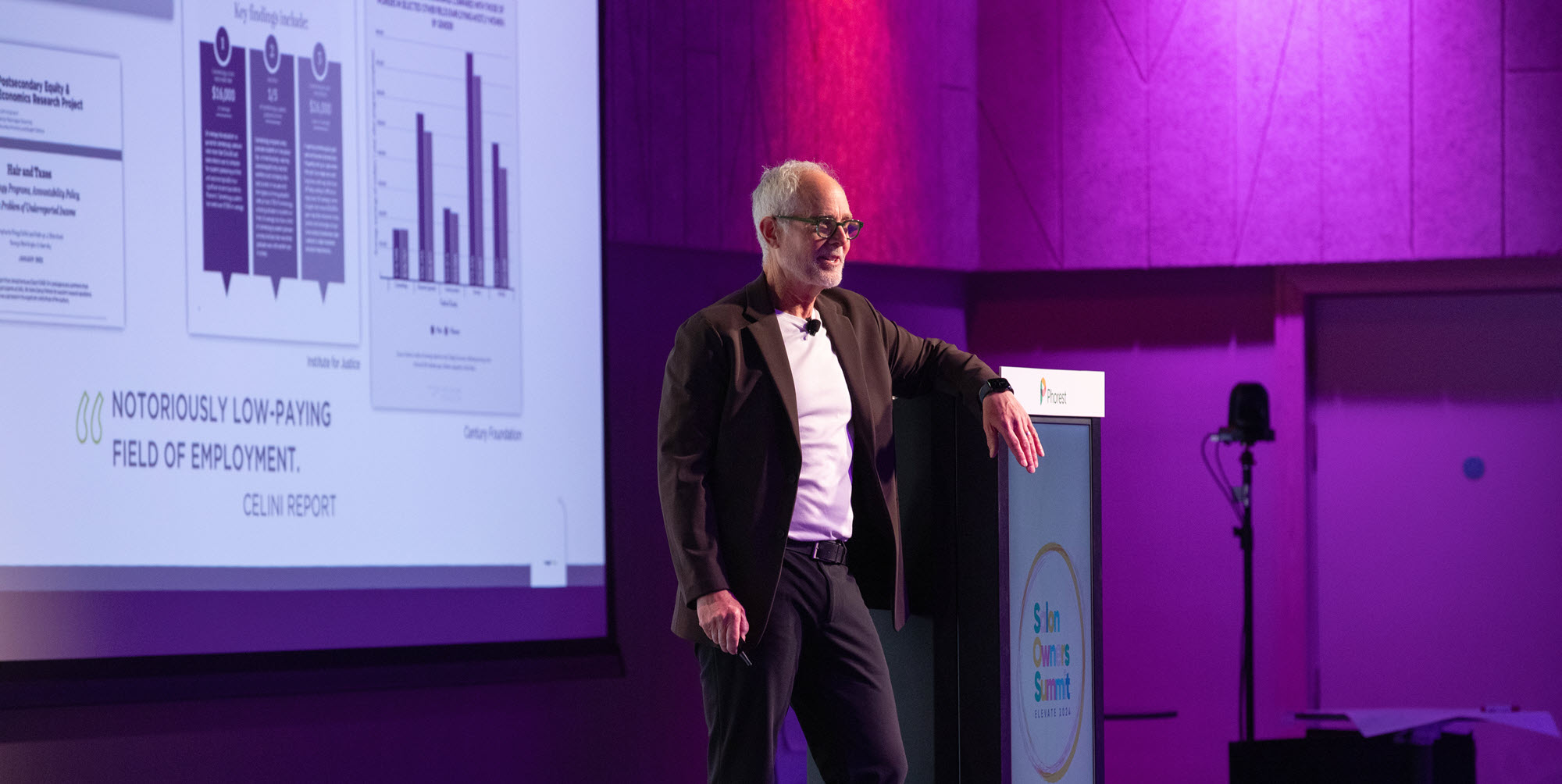During his Main Stage talk at the 2024 Salon Owners Summit, Tom Kuhn, CEO of Qnity – an organisation offering education and tools for economic empowerment in the beauty industry – brought attendees through the latest research carried out by Qnity’s research arm, Qnity Institute. The research looks into the earning potential and working conditions of salon professionals in the US. In this recap we’ll summarise the core points from the Qnity Institute research, empowering you to have honest conversations with your team about their financial prospects.
‘I Believe I’m Underpaid’ – the Story of ‘Adam’
Tom told the story of a man named Adam he had spoken to, who was a master stylist and educator at a prominent salon, but believed he was underpaid. Because of this, Adam wanted to look for a job elsewhere, and even considered leaving the industry. The room rumbled in recognition. Almost every salon owner or manager has been in this position, where an employee approaches them asking for an increase in remuneration.
Tom continued with the story – on asking Adam what he was earning, Adam said he didn’t know exactly. He wasn’t big on finances or maths, but he knew that what he was making wasn’t covering what he needed it to. When Tom and Adam looked at his finances together, they realised he was earning over $140k per year. He was in the top 10% of earners across the US, and likely taking home more than the owner of the salon. The room again erupted into a kerfuffle of recognition.
The Current Media Narrative About the Salon Industry
Aside from his obvious lack of financial data and understanding, there were also outside factors contributing to Adam’s sense that he should be earning more. To illustrate this, Tom highlighted some choice quotes from various organisations’ research into the earning potential and working conditions in the salon industry that crop up consistently in the media –
- “Near-poverty levels of wages in a low-tier profession” – Century Foundation
- “Notoriously low-paying field of employment” – Celini Report
- “Earn low wages and work long hours with very little time off” – Institute for Justice
According to research from PWC, financially stressed employees are 200% more likely to look elsewhere for employment. One of the salon industry’s greatest challenges is hiring and retaining staff. Seeing how common it was for salon professionals to believe they are underpaid, either due to financial literacy issues or the narrative in the media, while on the flipside seeing high-earners like Adam bringing home income in the top 10% of the country, Tom and the Qnity Institute decided to carry out their own research.
Closing the Gap Between Perception and Reality
The Qnity institute carried out a study in the US, to answer the question ‘What does compensation look like for a career in the professional beauty industry?’. Their published report, ‘A Career in Pro Beauty. Compensation Study Data & Insights’, studied the earnings that salon professionals submitted to the US government at year-end (their W-2 form) – which covers all of their taxable earnings – e.g. commission and tips – not just base wages.
Their study highlighted some stark differences to the stats that were publicised up to now.
- According to the 2022 US Bureau of Labor Statistics, the average hourly wage for a salon professional is $16.06. The Qnity Institute study showed an average of $40.50 per hour
- The median annual pay according to the US Bureau of Labor Statistics was $33,400, while the Qnity Institute study showed it was $54,650
- However, the Qnity study also showed that the average salon professional only works 26.4 hours per week, while the standard working week in the US is 40 hours
- Therefore, if a salon professional chose to work a full 40-hour week based on the figures in the Qnity study, they had the potential to earn a median annual pay of $84,000
- Bearing in mind this is just the median figure, the study found that 1 in 4 salon professionals in the US (25%) would earn over $100k if they choose to work a 40-hour week
- In terms of flexibility, it was found that 54% of employers across other industries in the US offer some form of working schedule flexibility, while 99% of beauty/hair businesses offer some or even total flexibility.
The study was carried out by Qnity Institute, with sponsorship from Phorest, Wella, Aveda, Pivot Point, 2to10, AACS, Moroccan Oil, Milady and Qnity Inc.
Money Management
So, if the figures in the Qnity Institute study are closer to the reality of the earning potential in the professional beauty industry, then why is it still so common for salon owners to be approached by their employees with stories of their financial struggles?
To find out whether it might be a money management problem, rather than a ‘money in’ problem, Qnity carried out a survey among 6,000 cosmetology students and 1,000 licensed industry professionals.
The study found that, indeed, there is a high rate of financial literacy issues among students and professionals in the industry:
- 69% reported feeling money anxiety
- Only 50% felt that they were financially confident
- 77% of students and 70% of professionals felt they lacked financial education.

In support of these findings, Qnity Inc offers financial wellness courses and resources for beauty industry professionals. Find out more at https://qnityinc.com/
Feeling the Salon Owners Summit FOMO?
Want to make sure you’re in the room to hear insightful talks like this next year? Get your tickets for the next Salon Owners Summit!



